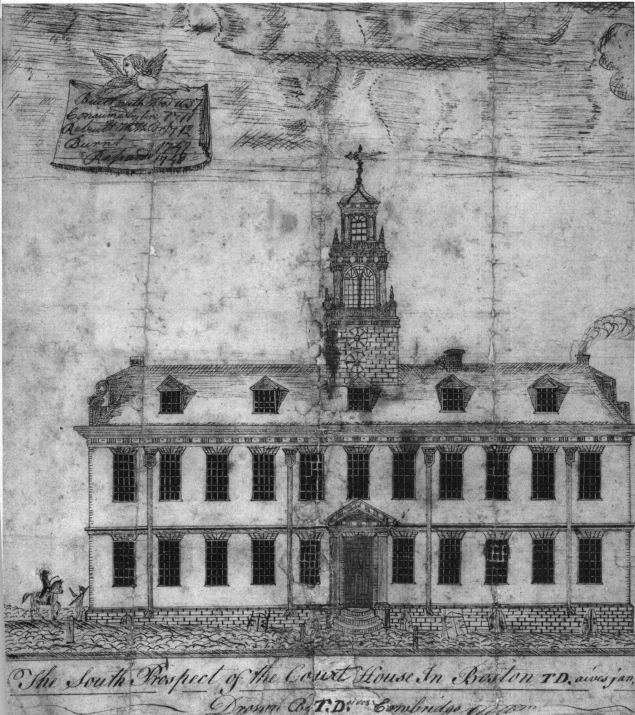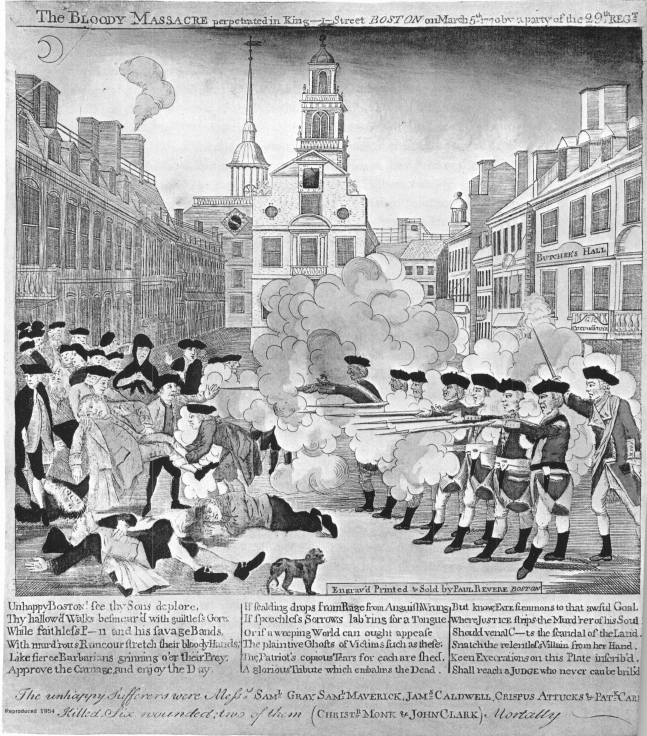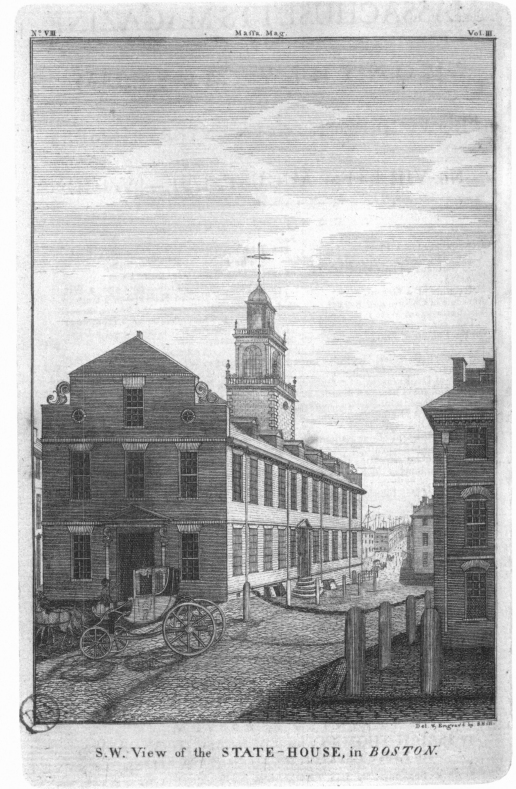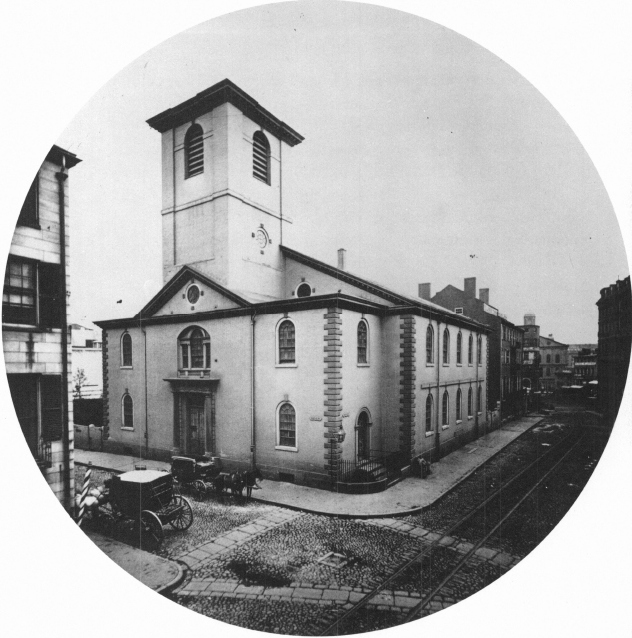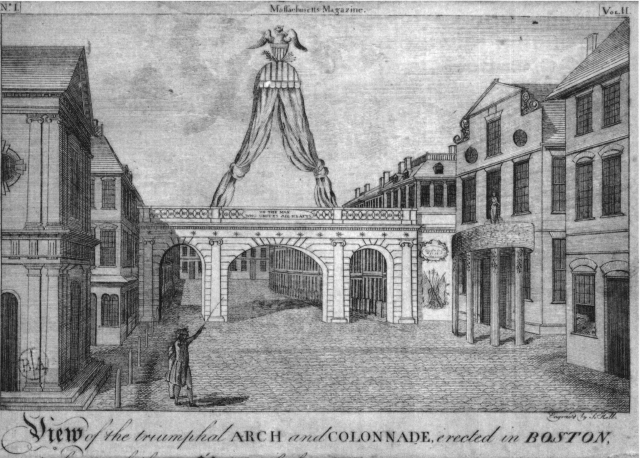A Recently Discovered Engraving of The Old State House in Boston
THE discovery of an hitherto unrecorded colonial print is always a matter of excitement. The engraving which forms the subject of this paper came to light recently in New Hampshire where it had hung for many years in its original frame on the walls of a house occupied by a person with remote Boston connections. As the inscription reveals, the print represents a south prospect of the “Courthouse” in Boston, dedicated to Thomas Hubbard, Speaker of the House of Representatives, by James Buck. Mr. Buck was a Boston printseller, and this information is confirmed with the statement at the bottom of the print: “Printed & Sold by James Buck at ye Spectacles in Queen St.—1751.” More important yet, we are informed in the lower left-hand corner that the design could be credited to Thomas Dawes, Jr. (“T: Dawes Junr del.”). In the lower right-hand corner, the engraver is identified as Nathaniel Hurd (“N. Hurd sculp.”).
No knowledge of this print seems to have existed in 1882 when the Re-Dedication of the Old State House was published by the City Council—a thorough compendium of the history early and late of Boston’s chief surviving public building from the colonial period. It is interesting to realize, however, that while no recent scholars seem to have taken notice of the fact, the engraving was advertised at the time of its publication. We are told in the July 2, 1751, issue of the Boston Gazette that there was then “To be Sold by James Buck opposite the Crown and Comb in Queen-Street. A South Prospect of the Court-House in Boston.” And it was known to one early copyist at least, perhaps a school girl, in a pen-and-ink drawing which has hung for a number of years upon the walls of Walter Whitehill’s office at the Boston Athenæum. Some of the explanatory matter has been copied as well, though it is interesting to note that the copiest has transcribed T. Dawes as “T. Daives,” and the Junior as “jan.” For reasons which are inexplicable, he or she has identified Mr. Dawes as being of Cambridge, Massachusetts.
What do we learn from this important discovery? It enlarges our knowledge of: (1) the Old State House as an architectural entity; (2) the life and work and (ultimately) the significance of Thomas Dawes; and (3) Nathaniel Hurd’s creative output. Taking each of these three elements in turn, we discover first concerning the Old State House that its present basic form took shape through a rebuilding following a fire in 1711 which destroyed its wooden predecessor. On October 22, 1711, it was moved in the Provincial Assembly “that there be a House built in or Near the place where the Old Town House Stood . . . The breadth not to Exceede thirty six feet the length So as to be Convenient . . . That a Committee be Appointed by this Court to Take Care for the building as speedily & prudently as may be.” On November 10 of that same year “Elisha Hutchinson and Penn Townsend Esqr with such as shall be Named by the Representatives be a committee for the affair. The Committee to Advise with his Excsy & such skillful Gentlemen they may think fitte to be consulted with about the Model of the House.” The record, however, does not yield the name of the person (or persons) who furnished this “Model.” The Re-Dedication mentioned earlier, published in 1882, is the standard source for the documentary information concerning the aspect of the building in its early eighteenth-century form, amplified to some extent by visual evidence furnished through a detail from the William Burgis view of Boston in 1723.
On Wednesday, December 9, 1747, the Boston Weekly News Letter informs us that the woodwork under a hearth took fire and ignited the building in dead of winter “whereby that spacious and beautiful Building except the bare outward Walls, was entirely destroyed.” The structure was forthwith rebuilt, an event commemorated upon its completion by the Hurd-Dawes view.
79. The South Prospect of the Court House In Boston
80. The Bloody Massacre, 1770
Until the discovery of this engraving our knowledge of the appearance of the building after its rebuilding had been imperfect. Paul Revere’s celebrated representation of the Boston Massacre provides a glimpse of the east end at least through the smoke of battle shortly before the Revolution. Until now, however, the most circumstantial of the early views was that to be found in the Massachusetts Magazine for 1791, executed some forty years after the Old State House had been rebuilt. And although a continuing flow of nineteenth-century views documents the changing aspects of the building, radical changes after the Civil War have rendered less certain our precise knowledge of how it appeared before this successive overlay of alterations. The restoration in 1882, needless to say, occurred at a time when scholarly techniques in the field of restoration had scarcely begun to be refined.
Thus while the Hurd-Dawes and Massachusetts Magazine views may not be radically different in style and technique, the Hurd-Dawes view is the earliest and shows the building broadside. We gain explicit architectural knowledge about such minor features as downspouts, bulkheads, and dormer windows, to say nothing of quite circumstantial evidence concerning the south side entrance and the tower. Thus this view comes as a very special boon to the architectural historian.
Our second consideration is Thomas Dawes, the person responsible for the design which Hurd engraved. Some years ago, I spoke of the life and work of Thomas Dawes before the Colonial Society, placing him in context with other building artisans of eighteenth-century Boston. I shall reiterate here only the salient facts of his life in order to illuminate the significance of his association with the Hurd engraving. He was born in 1731 into a family dynasty of building artisans related by blood and marriage which looms far larger than any other such example known in colonial Boston. The Dawes family tree illustrates the strong continuity of a single occupation throughout five generations. Commencing with the immigrant ancestor, William Dawes, a seventeenth-century mason, mentioned in Sewell’s diary, we note that his brother-in-law and his three sons and three nephews (or nephews-in-law) were all masons. His grandson was a mason. In the fourth generation, his great-granddaughters married a painter and two housewrights, one of whom was William More, well known for his execution of much of the woodwork for the Hancock House. In the fifth generation, there were three housewrights, one painter, and four masons, including Thomas Dawes, the most celebrated member of the family. Over and beyond his trade, Thomas Dawes became a conspicuous public figure as well. He joined the Old South Congregation in 1749 and was a deacon of that church from 1785 until his death. He was spotted early for civic positions. In 1759 and 1761 he was chosen coroner in Boston, and in 1767 was put on a committee for the encouragement of the manufacture of duck. He was a member of the Long Room Club, composed mostly of patriotic young men, and was called by the Tories “Jonathan Smoothingplane.” His house in Purchase Street, next door to Sam Adams, was sacked by the British, and his brother, William Dawes, as history records, rode with Paul Revere at the time of the Lexington and Concord disturbances. Thomas Dawes himself was adjutant of the Boston Regiment and rose to the rank of colonel. After the adoption of the state constitution he was a representative, senator, and councilor, and was three times chosen an elector of the United States. His rise is also traced in the deeds. He calls himself a bricklayer until about 1770, and thereafter most land transactions identify him with the title “Esquire.” In the first Boston Directory of 1789 he is listed as the Honorable Thomas Dawes, and his name heads all the others under the D’s. Following his death in 1809, he was buried next to King’s Chapel with one of the most imposing monuments which survive in that yard.
81. S. W. View of the State-House, in Boston, 1791
His professional life was anything but routine. While characteristic masons’ bills can be found, for example his repairs to and whitewashing of the Old State House in 1773 with a list of his men who performed the work, he also laid the cornerstone of the Brattle Street Church on June 22, 1772. The church records reveal that a design had been solicited from the colonial portrait painter, John Singleton Copley, and that this design was rejected. Who was responsible for the ultimate appearance of the Brattle Street Church? Was it Dawes? The Massachusetts Magazine for January 1790 informs us that he designed the colonnade of the Triumphal Arch built for Washington’s visit to Boston in 1789, and when a state senator, full of years and honors, he was chosen to be one of the three men appointed to the committee to undertake the building of the new State House in Boston in 1795, a committee which included Charles Bulfinch. His role here may well have been advisory only. His tombstone inscription, however, is provocative: “Of his taste for the Grecian Simplicity in ARCHITECTURE, there are many Monuments which he raised when that Art was new to us.”
82. Brattle Street Church, 1857
83. View of the triumphal Arch, 1790
Some day we may know more of his role as an architectural designer. Of particular importance in this connection is his library of architectural works given following his death by a son to the Boston Athenæum. Of more than a dozen items, mid-eighteenth century in date or earlier, the majority are practical builder’s manuals. At least three items, however, are formal design books: James Gibbs’s Book of Architecture and his Rules for Drawing the Several Parts of Architecture, and Colen Campbell’s Vitruvius Britannicus. In any event, whatever role Thomas Dawes may have played in the rebuilding of the Old State House after the fire of 1747, the Hurd engraving is of vast significance, for it is the first and only source to date which illustrates Thomas Dawes’s perfectly respectable drafting ability—derived presumably from a study of the books in his possession, hardly to be expected in a run-of-the-mill mason or bricklayer, and executed when he was but twenty years old!
Turning now to our third and final consideration, that of the engraver Nathaniel Hurd, we note that he too was quite young, only twenty-one years of age at the time the engraving was executed. He is remembered today both as silversmith and engraver, and his first dated bookplate was executed in 1749. It would be presumptuous of me to comment on the quality of the State House engraving in this distinguished company of authorities on the graphic arts beyond noting that Nathaniel Hurd’s biographer, Hollis French, writes in 1939 that “Of the fifteen known examples of Nathaniel Hurd’s engravings, other than his bookplates, there are none of any great artistic merit, though some are quite good.” He illustrates none of these though he describes all the then-known examples including trade cards, bills of exchange, loan certificates, tables of coins, portraits, caricatures, dance invitations, masonic summons, etc. Suffice it to say that the State House view would appear at present to be his only formal, full-scale “portrait” of a building. Beyond this and with respect to the artistic merit of this highly important historical document, I happily submit to the judgment of others.

